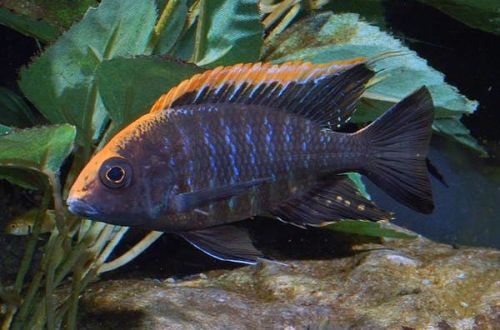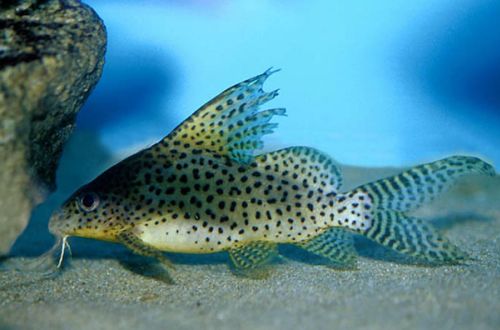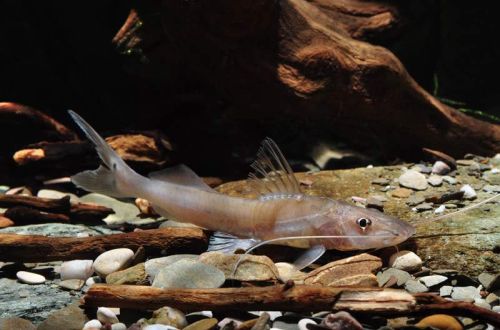
Exodon
Exodon paradoxus, scientific name Exodon paradoxus, belongs to the Characidae family. The name contains the word “paradoxical” which reflects the amazing behavior of this fish. This is a flocking species, but at the same time, each individual individual lives on its own and can attack a relative if it considers that it is weak / sick or if it just wants to eat. They are small, but at the same time they are able to attack a large predator, as if guided by the principle – first bite, and then ask questions. Life is seething in their flock, but they show special fury during feeding. If you like piranhas, but don’t have the resources to set up a large aquarium and provide them with plenty of food, then Paradoxical Exodon is a great alternative.

Contents
Habitat
Widespread throughout much of the Brazilian Amazon (South America), as well as in Guyana. Usually found in sections of rivers flowing through savannahs and other steppe areas, such as pastures and other agricultural land. Such biotopes are characterized by moderate currents and sandy substrates.
Brief information:
- The volume of the aquarium – from 120 liters.
- Temperature – 23-28°C
- Value pH — 5.5–7.5
- Water hardness – soft to hard (0-20 dGH)
- Substrate type – sandy
- Lighting – moderate
- Brackish water – no
- Water movement – moderate or weak
- The size of the fish is up to 10 cm.
- Meals – fresh or frozen meat products
- Temperament – active, carnivorous species, incompatible with other fish
- Keeping in a large flock, preferably at least 20 individuals
Description
Pretty small fish, adults barely reach 15 cm, and in a home aquarium they grow even less – up to 10 cm. The differences between the sexes are minimal, males differ only in slightly elongated dorsal and anal fins, but they look slimmer. The predominant color is silvery with red fins, a characteristic feature is the presence of two large dark spots. The first is located on the body behind the gill covers, the other at the base of the tail. It has a unique mouth structure, sharp teeth are pushed forward, allowing, like tongs, to tear off pieces from the body of other fish.
Food
A carnivorous species, in nature it feeds on a variety of insects, small crustaceans, as well as small fish, if it can fit in their mouth, otherwise Exodons, if possible, bite off fins, tails, scales and pieces of the body from other fish, or from their own weakened or sick relatives.
At home, they accept any meat products, it can be chopped pieces of mussels, shrimp, fish, worms and insects. Although they live in packs, but in the process of feeding, there is only one principle – every man for himself, so make sure that everyone gets enough food. Otherwise, over time, some fish will weaken from hunger and their fate will become unenviable.
Maintenance and care, arrangement of the aquarium
The minimum allowable tank size starts from 120 liters. The design can be anything, they often use a sandy substrate and a certain amount of snags for decoration. However, taking into account the habits of fish, it is recommended to equip several shelters in the form of dense thickets of plants with additional branchy snags or artistic objects, such as sunken ships, castles, etc. In these places, fish that are attacked by their relatives will find shelter and be able to recover. and there will certainly be.
Exodons produce a lot of waste, and pieces of uneaten meat food greatly pollute the water, only a productive filtration system can cope with this together with a weekly replacement of part of the water (15–20% of the volume) with fresh water.
Optimal conditions of detention, in addition to the absence of pollution, are characterized by the presence of a moderate current and light level, water temperature in the range of 23-28 ° C, acidic or slightly acidic pH value at any hardness value (from soft to hard).
Behavior and Compatibility
Despite their size, they are very dangerous and bloodthirsty creatures. Contained exclusively in the species aquarium. Not a single fish, even large and predatory, will feel safe. Exodons are something like petty criminals gathered in a bunch, but at the same time ready to attack each other, outwardly it seems that they are constantly quarreling. The aquarist should be prepared that outcast fish will appear in the process of keeping, which are weakened from a lack of food or have been injured. If no action is taken, they will soon be killed and eaten.
Breeding / breeding
Getting offspring at home is difficult, but possible. There are many nuances, so only the most persistent or experienced aquarists achieve success. The best way is to create a separate spawning aquarium. A tank from 40 liters is suitable, only a few plants are enough in the design. A fine-mesh net or a layer of glass balls with a diameter of about 1 cm is laid on the bottom. This design protects the eggs from their parents when they fall under the net or roll into the spaces between the balls. The set of equipment is identical to the general aquarium, but in this case the filtration system must consist of a simple sponge filter, otherwise the fry will be demolished and sucked in.
The stimulus for spawning is a gradual decrease in water hardness to 1–5 dGH and the establishment of a slightly acidic pH value at around 6.0–6.5. After some time, some of the fish will noticeably round out – these are females filled with caviar. Future parents (choose the strongest and healthiest individuals) are placed in a separate tank, set up in advance and filled with water from a common aquarium. They should live in it for about a week. Remember to perform water changes in the spawning aquarium and remove waste products, as a weak filter is not able to provide the necessary cleaning.
Spawning can be initiated by lowering the temperature to 23°C by changing the water to cooler water during the day.
When the eggs are laid, the fish are returned back. Fry appear in the first 2-3 days. Feed microscopic food – brine shrimp nauplii and / or ciliates, then adult brine shrimp, daphnia. In addition, the fry will feed on each other, but this should not surprise you, this is normal practice for them.
Fish diseases
Paradoxical exodons are not prone to any diseases, the only real threat is poisoning by the decay products of organic residues (excrement, uneaten pieces of food). Thus, regular maintenance of the aquarium minimizes the risk of disease.





